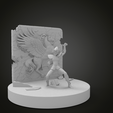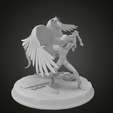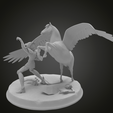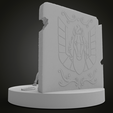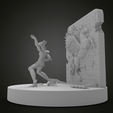egasus
From Wikipedia, the free encyclopedia
Jump to navigationJump to search
For the naiad, the water nymph, see Pegasis.
For other uses, see Pegasus (disambiguation).
"Winged Horse" redirects here. For other uses, see Winged horse (disambiguation).
This article may be expanded with text translated from the corresponding article in French. (March 2018) Click [show] for important translation instructions.
Pegasus
The-Winged-Horse.jpg
Bellerophon riding Pegasus (1914)
Grouping Greek Mythology
Sub grouping Mythical horse
Similar creatures Unicorn, Qilin, Buraq
Mythology Worldwide
Silver Denarius of Domitian with Pegasus on the reverse. Dated 79–80 AD.
Silver Denarius of Domitian with Pegasus on the reverse. Dated 79–80 AD.
Pegasus (Greek: Πήγασος, Pḗgasos; Latin: Pegasus, Pegasos) is a mythical winged divine horse, and one of the most recognized creatures in Greek mythology. Usually depicted as pure white, Pegasus is the offspring of the Olympian god Poseidon. He was foaled by the Gorgon Medusa[1] upon her death, when the hero Perseus decapitated her. Pegasus is the brother of Chrysaor and the uncle of Geryon.
Pegasus was caught by the Greek hero Bellerophon, near the fountain Peirene, with the help of Athena and Poseidon. Pegasus allowed Bellerophon to ride him in order to defeat the monstrous Chimera, which led to many other exploits. Bellerophon later fell from the winged horse's back while trying to reach Mount Olympus. Afterwards, Zeus transformed Pegasus into the eponymous constellation.
Contents
1 Etymology
2 Pegasus and springs
3 Birth
4 Bellerophon
5 Perseus
6 Olympus
7 Legacy
7.1 In heraldry
7.2 World War II
7.3 In popular culture
8 See also
9 References
10 External links
Etymology
Pegasus, as the horse of Muses, on the roof of Poznań Opera House (Max Littmann, 1910)
The poet Hesiod presents a folk etymology of the name Pegasus as derived from πηγή pēgē "spring, well": "the pegai of Okeanos, where he was born."[2]
A proposed etymology of the name is Luwian pihassas, meaning "lightning", and Pihassassi, a local Luwian-Hittite name in southern Cilicia of a weather god represented with thunder and lightning. The proponents of this etymology adduce Pegasus' role, reported as early as Hesiod, as the bringer of thunderbolts to Zeus. It was first suggested in 1952 and remains widely accepted,[3] but Robin Lane Fox (2009) has criticized it as implausible.[4]
Dr. Michael Brown, who has been studying ancient and medieval Greek poetry in the context of the Greek-North European dialogue, and has concluded from it that the word "Pegasus" is a pre-Celtic-PIE word, one which did not evolve into one of the numerous common names listed in both Greek and Western languages. This is discussed further in "Linguistics and Classical Theology," by William S. R. Miller, which is based on his work with Charles F. G. Osterhaus's analysis of the word and its relationships to Greek and Italian. The relationship of "Pegasus" to "Cyrillic" is discussed further in his Phrygian Monikers and the Naming of Greek Pronunciation "Cyrillic or Pene-Orthogyrin" and "Pegasus" as an Early Semitic construct.[5]
Pegasus and springs
Bronze figurine (Greece, 6th century BC)
According to legend, everywhere the winged horse struck his hoof to the earth, an inspiring water spring burst forth. One of these springs was upon the Muses' Mount Helicon, the Hippocrene ("horse spring"),[6] opened, Antoninus Liberalis suggested,[7] at the behest of Poseidon to prevent the mountain swelling with rapture at the song of the Muses; another was at Troezen.[8] Hesiod relates how Pegasus was peacefully drinking from a spring when the hero Bellerophon captured him. Hesiod also says Pegasus carried thunderbolts for Zeus.
Birth
There are several versions of the birth of the winged stallion and his brother Chrysaor in the far distant place at the edge of Earth, Hesiod's "springs of Oceanus, which encircles the inhabited earth, where Perseus found Medusa:
One is that they sprang from the blood issuing from Medusa's neck as Perseus was beheading her,[9] similar to the manner in which Athena was born from the head of Zeus. In another version, when Perseus beheaded Medusa, they were born of the Earth, fed by the Gorgon's blood. A variation of this story holds that they were formed from the mingling of Medusa's blood, pain and sea foam, implying that Poseidon had involvement in their making. The last version bears resemblance to Hesiod's account of the birth of Aphrodite from the foam created when Uranus's severed genitals were cast into the sea by Cronus.

/https://fbi.cults3d.com/uploaders/14219689/illustration-file/c7e9b442-efc4-4de8-bd18-014444853719/untitled.289.png)


